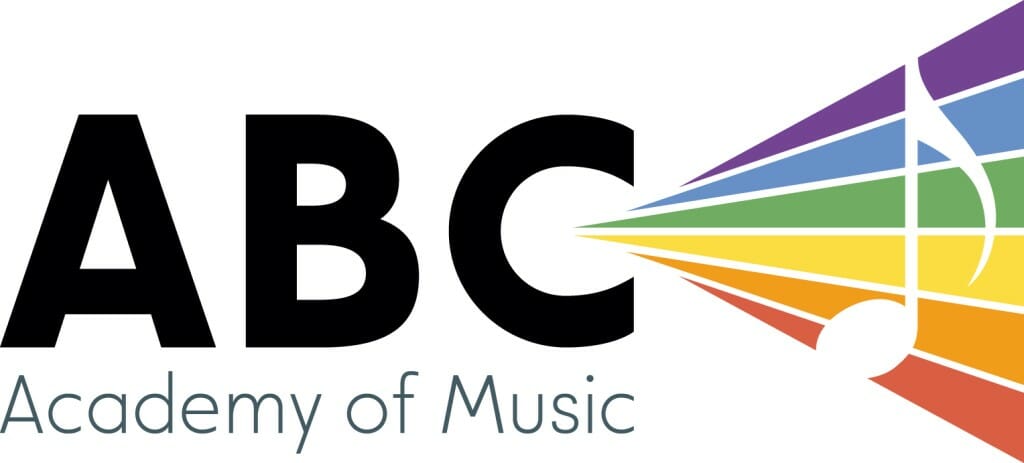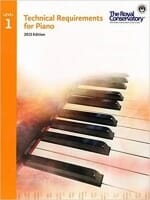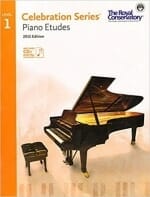Mezzo-Soprano Emma Berube (she/her) showcases a range of repertoire in art song, opera, and music theatre. From Bach to Debussy and Sondheim to Schwartz, she has an appreciation and expertise for a wide range of music that tells a story.
Emma achieved her Bachelor of Music from the Don Wright Faculty of Music at Western University in 2023. During her time at Western she was involved in several theatrical, music theatre, and choral productions. Emma’s goal during her time at ABC is to connect with students through music and help them become proficient and confident musicians and humans.
Get to know Emma…Beyond the Bio!
Hobbies: Reading, Writing, Spending time with friends and family
Musical Influences: Stephen Sondheim, Jason Robert Brown, Taylor Swift
Favourite Food: Strawberries
Least Favourite Food: Olives
Favourite Song: Evermore – Taylor Swift
Favourite Movie: Little Women – Greta Gerwig
Favourite Movie Music: Peter Pan – James Newton Howard
Favourite Musical Theatre/Opera: Company – Stephen Sondheim
Best Quote from your Teacher: “Run as Fast as You Can”
Favourite Book: The Secret to Superhuman Strength – Alison Bechdel
Latest Homework from Emma
Is Emma Your Teacher?
Sign up now to get your weekly assignments delivered, and never lose your homework sheet again!
Assignments from June 12th:
Hello Everyone!
Friendly reminder as we approach the end of the spring term, if you are interested in continuing lessons through the summer please reach out to Barnaby to claim a time slot. You can also renew for the fall semester as well. If you would like to keep your current time slot reach out to Barnaby ASAP.
Noreet:
Today we reviewed The Clock Strikes Thirteen! The song is short and straight forward, so when practicing, Noreet should focus on playing accurate rhythms and ensuring the right and left hands line up properly. Pay close attention to the half notes and eighth notes in the piece. Remember, the half note (2 beats) is twice as long as the quarter note (1 beat) and the eighth note (1/2 beat) is half as long as the quarter note. Use the metronome when practicing this song to help Noreet hear the Macro beat of the song. Please play the metronome at 85 Beats per Minute. I’ve also uploaded a rhythm worksheet for Noreet to complete. The sheet asks her to identify the eighth notes, quarter notes, and half notes on the page. She can circle these or colour them in. She then needs to write in where the macro beat and micro beat line up. See the first bar as an example. Finally, have Noreet play the 6 phrases hands separate and hands together. We will review this next week in class. You can find the rhythm worksheet here.
Christian:
Continue to practice Home on the Range. Isolate any bars that have gaps between them and practice playing through both to the end. When you can play these parts without hesitating, go back and play the whole phrase together. We also started Ode to Joy! When practicing, play this hands together. The left hand consists of sustained notes or phrases either a 3rd, 5th, or an octave below the melody line in the right hand. Other than that, the phrases in the two hands are identical. See if you can play this whole song start to finish hands together for next class. Finally, please remember to upload the sheet music of How Long Will I Love you for me to review. You can upload this to Student Uploads or to the Christian folder on google drive.
Thank you everyone!
I look forward to hearing how you all progress in our final few spring classes together!
Happy Practicing!
Assignments from Thursday May 29th
Hello Everyone!
Noreet:
Continue to practice Daydream hands together slowly. Review the third phrase hands separately when necessary. Remember the 4th phrase is identical to the first phrase! The last part has similar parts to the beginning of the song, just remember to play one octave up! When in doubt, re-read the sheet music and go back to practicing hands separate before trying hands together again. Noreet can also practice “The clock strikes thirteen”. We read this together in class together. Re-read this at home and review the song hands separately. The left hand plays the same chord for the whole song, so when Noreet feels confident with the right hand she can try to play the whole song hands together. We also learned what Crescendo and Diminuendo mean. When practicing “the clock strikes thirteen”, encourage Noreet to try playing louder and softer when the crescendo and diminuendo symbols appear in the music. We will review this in class next week.
Eva:
Continue to practice Sailing in the Sun hands together! If Eva forgets the final phrase of the song, remind her that most of the line is made of bars written in the song earlier – she’s already played them in the previous phrases! When she is ready to play the full song, encourage her to do so with as few pauses between phrases as possible. Challenge her to play as fast as she can. Review the first 2 phrases of Ferris Wheel together. If Eva gets stuck or forgets the notes, pull out the flashcards! Ask her to identify each note she sees in the phrase and to put them in order. Then go back to the sheet music and encourage her to play the full phrase hands together. Challenge Eva to read the 3rd phrase of Ferris Wheel with the flashcards as well.
Christian:
I’ve uploaded Homeward bound for you to the google drive. Review this hands separately to start. When you feel familiar with the sheet music, try playing hands together to fill in the gaps in the melody. You can also continue to practice Morning. Focus on consistency in this piece; each note is played with the same amount of pressure and played legato. You can find Home on the Range here.
Great work this month everyone! I look forward to hearing more progress in June!
Happy practicing!
Assignments from May 15th
Hello Everyone!
Noreet:
Welcome back! We were talking about the student recital before you left for Europe, it was supposed to be May 4th in person but unfortunately we had to cancel. However we are offering a digital recital instead! Today Noreet recorded “Ice Cream” and “More Ice Cream” to be added to the digital recital. Barnaby will be compiling all the submitted student performance videos for families to watch and enjoy at home! We also reviewed Daydream. Noreet can slowly start to play this song hands together. Warm up with the 3-5-4 exercise at the top of the page. When practicing, review the right and left hand separately to start, then try playing the first phrase hands together slowly. Once you feel confident with how to two parts line up musically and how they feel together in your hands, you can practice the second phrase hands together. Repeat the process until you can navigate the whole song hands together. We can review any challenging areas next week.
Vida:
(Assignments from our make-up class, May 17th)
It was great to see you at Lawrence Park today! Now that you are confident with both the right and left hands of “Under the Sea” work towards playing the whole song hands together. Play slowly to allow your hands the time to line up in the music. Pay close attention to the macro beat of the song. Write this in like we did with the first bar if the visual helps you to see which hand moves first. Remember that the left hand is twice as slow as it is mostly half notes – your right hand will move faster than your left. Once you can confidently play the whole song with both hands, we can learn Ed Sheeran’s “Under the Tree” or another song from your list. Focus on playing the first phrase hands together, reviewing the song hands separate in between if necessary. Once you feel confident playing the first phrase hands together, you can work on the second phrase hands together. Repeat this process for the whole song. For Mr. McGill’s Boop Sha Bop, focus on the highlighted bars (sticky notes). Isolate these bars, follow the instructions on the sticky note (faster eighth notes, slower quarter notes, play through the bar to the next bar), then go back and play the song again with these corrections in mind. Practicing with the metronome will help highlight some of these challenges. Aim for a tempo of 100BPM. Finally, sight read Loch Ness! We will review this together in class next week.
Eva:
Sorry we missed you this week! I look forward to hearing you play “Sailing in the Sun” next week!
Christian:
I hope you had a safe flight and are enjoying the wedding in Mexico!
Thank you everyone!
I look forward to learning more music next week!
Have a great long weekend!
Assignments from May 8th
Hello!
I just wanted to say thank you to everyone who submitted a video for the digital concert! I’m very much looking forward to seeing everyone’s performances!
Vida:
Great progress with Under the Sea! Continue to review the melody in the right hand. Read and play through bars 29-35 on their own this week. Encourage Vida to use all of her fingers when playing the passage in bars 31-32; dancing her fingers around the notes instead of moving her whole hand and wrist. Try the following fingering for that passage: 2/4-3-4-3/5. We can review this in class next week. When Vida is confident with these 7 bars, put them back into the whole song! Try playing the piece start to finish without stopping. You can also record the whole song for Vida to hear. Once Vida has mastered the right hand, go back and encourage her to sight-read the left hand! Read in small chunks and practice both hands separately this week. When practicing Mr. McGill’s Boop Sha Bop, make sure Vida’s eighth notes are twice as fast as her quarter notes. You can use the tapping exercise provided in the google drive as a visual aid; Vida will be able to see that the hand tapping the eighth notes is moving faster than the hand tapping quarter notes. In the context of the song, encourage Vida to think of the first eighth note of the pair as a trampoline or a springboard to the next note in the pair. Jump up to the next note quickly. You can also practice this song with a metronome to help Vida hear the macro beat of the song. Let Vida choose the tempo. Encourage her to choose a quick but manageable speed.
Eva:
Today we learned the last phrase of Sailing in the Sun! When practicing have Eva start with this phrase. Ask her to show you what she learned in class. Once she has reviewed the last phrase, she can go back and play the first 3 phrases for you. Help Eva become more familiar with the last phrase by drawing comparisons to bars that are similar or identical to bars in the first 3 phrases. Eva can circle identical bars with the same colour pencil if she would like. (Red for 2 matching bars and Green for 2 different matching bars). This will help Eva learn the “map” of the song and help her feel more confident when playing the whole song start to finish. You can also help Eva connect each phrase by asking her to play the last bar of the previous line and the first bar of the next line back to back. Do this for each phrase to help Eva hear and feel how each line flows into the next. You can then ask her to “perform” the whole song for you! You can also record Eva playing the song start to finish so that she can hear herself play! When listening back, ask Eva what she likes about what she hears and if there is anything she wants to review and polish.
Christian:
For this week when practicing How Long Will I Love You, focus on the left hand. Practice the large, broken chords slowly as you read each chord practice the stretch from your 5th finger to your 1st finger. Remember that most of the chords written are the same I, IV, and V (C, F, and G) chords from the intro of the song. This should make reading each individual note easier. Should you review the intro this week, remember that every other chord should be played twice as fast as written. We will review this in class when you return from Mexico. Continue to practice the melody in the right hand. Identify and review the larger intervals that appear in the melody to help you “map” the song. This will help your memory as it offers a landmark for where you are in the song and whats coming up (like that Major 6th that introduces the main melody in the descending eighth notes). Practice as much as you can between now and when you leave. Have a safe flight and a great time at the wedding!
Thank you everyone! Looking forward to more great lessons next week!
Assignments from April 24th
Hello Everyone!
Friendly reminder that our student recital is scheduled for next Sunday, May 4th at 1:30pm. It would be so great if all of you could attend even if you are not performing!
Noreet:
I hope you are having a fabulous time in Europe!
Vida:
For this week, please have Vida practice Rhino in the Mud! This is a great option for the recital. Help Vida record herself playing the song so she can hear, then ask her what specifically she likes about what she is doing and if there are any areas she wants to improve upon or change. Also, talk to her about the recital. Please remind her that “performance” is a skill on its own and requires practice as well. The recital would be a great chance to practice performing for an audience. The deadline to sign up is this Tuesday, if Vida does decide she want to perform, feel free to reach out to me via opus and I will add her name to the list. Continue to practice Mr. McGill’s Boop Sha Bop. Encourage Vida to use the metronome to ensure her eighth notes are “balanced” and stay in tempo. Vida should also use the second note in bars 10-12 and 14 as a “launchpad” to the next set of eighth notes. We will talk more about this in class next week. I’ve also uploaded a video of a rhythm exercise to the google drive for Vida to practice. With one hand, Vida is to tap quarter notes and with her left hand tap eighth notes at the same time. We tried this in class together, (its very much like rubbing your tummy and patting your head at the same time). Try this at different tempos so Vida can feel how the eighth notes fit into the quarter note. Please help Vida to sight-read more of Under the Sea before reviewing the material she played for me in class. Aim to read and practice at least 4 new bars so that Vida can add on to what she has already learned. You can find the video of the rhythm exercise here.
Eva:
This week we sight-read the second phrase of Sailing in the Sun! Please help Eva review these notes at home and encourage her to play this phrase for you! You can also take turns reading and playing. Have Eva name the notes as you play them then switch and help Eva name the notes as she plays. When she feels confident playing the second phrase, challenge her to play both the first phrase and second phrase together. Eva can also finish the colouring sheet I sent home. Have her assign a colour to each note, then ask her to find that specific note for that chosen colour e.x colour each F Green! The notes on the colouring sheet are identical to Sailing in the Sun, feel free to use the music in the book for reference and clarification if needed as I know Emma’s writing can be messy.
Christian:
This week please practice forming and playing the chords in your left hand for the first 8 bars of How Long Will I Love You. Also, sight-read as much as of the right hand in the 3rd phrase as you can on your own. When practicing the chords in the right hand at the beginning, focus on connecting each chord, with or without the roll. Use the metronome to ensure you are holing the chords for their full length. When practicing Morning, isolate any areas where you are pausing or are unsure of the notes. Practice these areas and bars on their own before connecting them back into the rest of the song. Work towards playing the whole song smoothly from start to finish by practicing at a slow tempo and slowly getting faster with each repetition. You can use the metronome for this if you find that helpful.
Thank you everyone for your hard work this week! I’ve seen some exciting improvements across all lessons. Keep up the great work!
Assignments from April 17th
Hello Everybody! Happy Easter!
I have a few updates and reminders for this week. First, progress reports have gone out this week! Please review these with your child at home and let me know if you have any questions next week. Also, please see the note on the bottom of the reverse side of the report for information about summer lessons and fall registration.
Second, our student recital is in two weeks! It will be at 1:30pm on May 4th! While not everyone will be performing, we do consider attendance mandatory as we find this is an important opportunity for students to meet their peers, and for students and families to experience and hear live music together. If we have talked about possibly participating in the recital, feel free to continue this discussion with your child at home. Have them choose one of the songs we have learned and encourage them to perform it for you for practice.
Noreet:
Today we reviewed our time signatures and where the big beat lines up in 4/4, 3/4 and 2/4 time. When practicing Mr. Haydn’s theme, use the metronome to ensure all quarter notes are played for their full value; specifically the 3 D’s in the 3rd bar of the song! This week, start trying to play Daydream hands together! Start by practicing the right and left hands separately at least, play both the right and left hand lines at least once before going back and trying to play them together slowly. Practice as much as you can from now until you leave for Europe. Have a great trip! I hope you and your family have lots of fun!
Vida:
Today we reviewed Mr. McGill’s Boop Sha Bop and Under the Sea. Please continue to work through Under the Sea slowly. Ask Vida to sight-read a phrase, then go back and review any challenging parts. Break down these challenging points into smaller chunks – even if that means practicing only 2 or 3 notes at a time – then go back and play the whole phrase again. Take breaks when necessary. When practicing Mr. McGill’s Boop Sha Bop try to connect the phrases. Pin point Vida’s “natural stopping points” and practice these bars specifically. Ask her to “bridge” the gap between these bars, play the bar before and the bar after to encourage a constant flow of sound before going back and playing the whole phrase start to finish. Finally, ask Vida to practice Green Frog Hop. I think this would be a great song to share for the recital! Use the music when necessary, but take it away when possible and challenge Vida to play from memory to help encourage her confidence in the song.
Eva:
Today we reviewed Sailing in the Sun. Please help Eva to practice this at home. Ask her to name the notes as you play them for her. When doing this please pretend you don’t know how to read the line and tell Eva you need her help to play. She can confidently identify middle C and is capable of finding the other notes by counting the lines and spaces up or down from C. You can then switch roles and ask Eva to play the notes as you name them. When doing this, please make sure to point to each note you name so that Eva can follow along, this will help reaffirm the name of the note to its position on the staff. Finally, challenge Eva to read and play the notes at the same time. Support her in this by reminding her its okay if she can’t play it super fast, encourage her to take her time and help to correct any mistakes or miss-steps should they occur. As a reward for her hard work on this song you can use the note value cards, the notes on the staff cards, and rhythm cards to help Eva write her own song. You can find those cards here.
Christian
This week, use the triads and inversions sheet I gave you as a warm up for both your right and left hands. After that you can practice the chord progression in “How Long Will I Love You”. Continue to review and practice the first 8 bars of the melody in the right hand of “How Long Will I Love You” and push yourself to sight-read beyond that. Read as much as you can. I’ve also uploaded “Morning” to the google drive for you to practice at home. Review this hands separate until you feel confident enough to try playing it hands together. You can find the two pages of “Morning” here.
Great lessons this week everyone! I look forward to more music making next week!
Assignments from June 14th
Hello Everyone!
Friendly reminder that summer lesson registration is open! If you are interested in continuing through the summer you should be able to register through Opus, otherwise Barnaby would be happy to help fit you into my summer schedule. Fall registration is also open! If you are taking the summer of, but would like to keep your time slot for the fall, register ASAP!
Vida:
I missed you today! Continue to practice Under the Sea, the Lochness Monster, and the chords for Ed Sheerhan’s I Don’t Care. I look forward to seeing you next week.
Berke:
For this week try practicing the entirety of Mozart’s Minuet in F Major hands together! As you put this together remember to isolate any bars you struggle with or phrases that have problem areas. Review these sections hands separately before going back and trying the phrase again hands together. I’ve also uploaded a sight-reading worksheet for you. Using coloured pencils, crayons, or markers, colour code the notes you see in the two phrases. Your starting note is a D! Choose a colour for D and circle or colour in every D that appears in the two phrases with that chosen colour. Repeat the process with the other to notes. After you have colour -coded the notes, you can write in the letter names underneath in the corresponding colour. We will review our lesson on the circle of 5ths and different key signatures next week. You can find the sight-reading worksheet here.
Thank you everyone!
I’m looking forward to hearing how you will progress in our final few classes of the spring semester!
Happy Practicing!
Assignments from May 31st
Hello Everyone!
Vida:
Continue to practice Under the Sea, working towards playing the first two pages hands together! Use the metronome if this helps Vida. Start at 60BPM then slowly increase the tempo. The ideal tempo for Under the Sea is 120BPM. Review any tricky or challenging spots hands separately when necessary. Review Green Frog Hop, Home on the Range, and Mr. McGill’s Boop Sha Bop specifically to highlight the difference in staccato phrases and legato phrases. Mr. McGill’s Boop Sha Bop asks Vida to do both. Continue to read Lochness Monster hands separately. We will review this in class next week. Finally, Vida can review the F# Major, D# minor, B, and C# chords as these will be used in Ed Sheeran’s “I don’t care”. When Vida feels comfortable building and playing these chords, add in the rhythm pattern from the song. We can add some of the melody next week.
Berke:
Today we read a new song! I’ve uploaded the sheet music for “Burlesque in G Major” to the google drive. Review this hands separately, when you feel confident playing both the right and left hands separately, you can try playing this hands together. Do the same for the minor section of Mozart’s Minuet in F Major. Focus specifically on the minor section. Only when you can confidently play the minor section hands separately should you go back and add the major section we have already learned. At that point, play the song from the beginning hands together and continue playing into the minor section with the right hand only so that you can hear how the song changes. Practice the Major section and minor section hands together separately. We can try to play the whole thing together in class next week. For Moonlight sonata, focus on building the chords in bars 7, 8, and 9 while holding down the upper note. Play these chords very slowly to build and practice this technique in your fingers. You can find Burlesque in G Major here.
Great work today! I look forward to hearing how both of you progress in June!
Happy Practicing!
Assignments from May 17th
Hello Everyone!
Vida:
It was great to see you at Lawrence Park today! Now that you are confident with both the right and left hands of “Under the Sea” work towards playing the whole song hands together. Play slowly to allow your hands the time to line up in the music. Pay close attention to the macro beat of the song. Write this in like we did with the first bar if the visual helps you to see which hand moves first. Remember that the left hand is twice as slow as it is mostly half notes – your right hand will move faster than your left. Once you can confidently play the whole song with both hands, we can learn Ed Sheeran’s “Under the Tree” or another song from your list. Focus on playing the first phrase hands together, reviewing the song hands separate in between if necessary. Once you feel confident playing the first phrase hands together, you can work on the second phrase hands together. Repeat this process for the whole song. For Mr. McGill’s Boop Sha Bop, focus on the highlighted bars (sticky notes). Isolate these bars, follow the instructions on the sticky note (faster eighth notes, slower quarter notes, play through the bar to the next bar), then go back and play the song again with these corrections in mind. Practicing with the metronome will help highlight some of these challenges. Aim for a tempo of 100BPM. Finally, sight read Loch Ness! We will review this together in class next week.
Berke:
Sorry we missed you this week! For practice this week, review Clair de Lune. Focus specifically on the fingering in the first 4 bars. Practice these eighth note figures slowly and focus on using the proper fingers. This will ensure your fingers don’t get tangled on their way down the keyboard and that we can reach the lower keys. Using the proper fingering will also help you play the phrase smoothly when we play at a faster tempo. When you feel confident and comfortable in the fingering of the first phrase, you can slowly increase the tempo. Challenge yourself this week to sight read 4 more bars of the song. The suggested fingering is written above each note. Give this a try when practicing and we can review this next week in class. When practicing Moonlight Sonata, try playing the first 6 bars hands together. Focus on reading bars 7-9 hands separately. You will have to play the upper notes of the right hands with your 5th finger! The upper note is played on each macro beat (the first beat of each chord). Pay close attention to when the notes in the chords change as they all look similar by change slightly every two beats. Finally your left hand for bars 7-9 is still playing in octaves so remember to use your 5th and 1st finger to play these notes. We will review both songs next week.
Have a great long weekend everyone!
Assignments from May 10th
Hello!
I have a few reminders and updates for you all. First, Berke has informed me that he does not have access to his chrome book this week! So if you could kindly remember to share this email with him that will be super helpful for Berke’s practice this week. Second, while I know the in person recital was cancelled, we are still going ahead with the digital concert! Berke and I record Minuet in F today to be added to the concert! Thank you Berke for your hard work on this piece, I am very much looking forward to seeing everyone’s performances!
Berke:
For this week please review Moonlight Sonata and practice the first 8 bars of Clair de Lune. Practice the fingerings as follows for the 3 alternating eighth note “motifs”. Eighth note group 1: 3/5 – 1/4 – 3/5 – 1/4. Eighth note group 2: 2/4 – 1/5 – 2/4. Eighth note group 3: 1/3 – 2/4 – 1/3. Please practice these bars slowly. This requires meticulous fine motor skills in the hand and fingers so pay attention to how this feel in your hand when you play these 3 bars. Use the metronome to help you stay in time, but start at 45BPM, switching chords with each tick of the metronome. Once your hands feel comfortable with this technique, you can slowly speed up to your desired tempo. Please review the upper notes only of the melody in bars 5 and 6 and continue to sight-read the second chunk of that melody in bars 7 and 8 on your own. Practice the eighth note groups and melody separately, put the two sections together only when both feel comfortable in your hands. Review what we have learned in Moonlight Sonata (bars 1-9). Review the chords in bars focusing specifically on bars 7-9 as this is newer material. Play these bars hands separate until you can confidently build and play the chords in the left hand. Review bars 5 and 6 slowly, playing close attention to which notes are played together and when. We will review and learn more Moonlight Sonata next week.
Excellent work today! I look forward to hearing more next week.
Assignments from May 3rd
Hello!
Berke:
You can choose to either video record Minuet in F Major at home and upload the recording to the google drive for me to submit. Or we can wait until next class to record together. For this week, when practicing Moonlight Sonata, focus specifically on bars 7-11. Please practice this section hands separately to start. Remember that this phrase moves in octaves in the left hand! Please sight-read the right hand of this phrase on your own; its very similar to bars 5 and 6, but pay close attention to where the triad changes. You can practice bars 5-11 hands together when you feel confident with the phrase in both hands. You also have a new song from this week – Clair de Lune! Please review the first 3 bars of this piece only. Pay close attention to the fingering markings and be sure to practice playing that 1/3 – 2/4 motion of the fingers in the right hand. When you feel comfortable with this technique, you can add in the left hand. I’ve also uploaded “Lost” for you to sight-read. You can use this as a warm up. Play this piece hands separately, we will revisit this song next week. You can find Clair de Lune and Lost here.
I’m looking forward to seeing your performance video! Happy Practicing!
Assignments from April 26th
Hello!
Friendly reminder that our recital is next Sunday, May 4th at 1:30pm! It would be so great if you could attend, even if you are not performing!
Berke:
For this week, I challenge you to play Minuet in F Major for other people; friends, family, anyone who will listen. This will help you practice performing! When playing the Minuet, practice pushing through even if a mistake happens! Persevere to the end, then you can go back an address any errors. You can also record yourself so that you can listen back to what you just played. When listening back, ask yourself what you like about the performance and what you want to improve for next time, if anything. Also, when listening to yourself play, please be sure to follow along in the sheet music; this will help highlight any areas that need improvement. When practicing Moonlight Sonata this week, focus on bars 5 and 6. Practice the triads in the right hand and the melody of the right hand separately. Make sure to practice playing those triads with your first, third, and fourth finger as you will need the fifth finger to play the melody. Only when you are confident with the chords on their own should you add in the upper melody on the G#. When putting the two ideas together, practice at half the speed you can play the res of the song. Pay close attention to how each note fits together like a puzzle. When your fingers are comfortable playing both bars 5 and 6 all together, go back and play the all 6 bars together start to finish.
Great lesson today! I look forward to hearing you play more Moonlight Sonata next week.
Preferred Books for Emma’s Students
Click to buy them here, and they’ll come right to your house! What could be easier?
Faber & Faber Piano Adventures
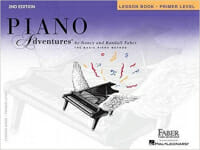
The 2nd Edition Primer Lesson Book introduces the keyboard, note values, and the grand staff. Students play in C 5-finger scale patterns, develop recognition of steps and skips, and learn letter names independent of finger number. Musicianship is built through the use of dynamics and coloristic experimentation with the pedal. The book is organized into units which represent the major concepts and skills. As new units are introduced, earlier concepts and skills are constantly reviewed.
Faber Piano Adventures
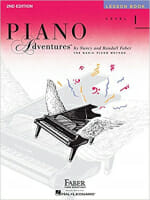
The 2nd Edition Level 1 Lesson Book introduces all the notes of the grand staff, elementary chord playing, and the concept of tonic and dominant notes. Students play in varied positions, reinforcing reading skills and recognizing intervals through the 5th. Musicianship is built with the introduction of legato and staccato touches. This level continues the interval orientation to reading across the full range of the Grand Staff. The 5-finger approach is presented here in a fresh, musically appealing way.
Belting - A

Written for ages 5 and 6, My First Piano Adventure captures the child’s playful spirit. Fun-filled songs, rhythm games and technique activities develop beginning keyboard skills.
The Brown Scale Book

This essential resource includes all major and minor scales, triads, arpeggios, dominant sevenths, and chromatic scales organized by key. A favorite for decades, The Brown Scale Book belongs in every student’s library.
